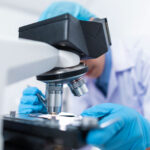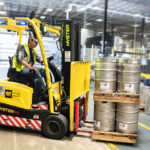To become a concert photographer, focus on building a strong portfolio and networking with industry professionals.

Credit: variety.com
Understanding Concert Photography
Concert photography is an exhilarating form of visual storytelling that captures the essence and energy of live music performances. It involves the unique challenge of freezing moments in time amidst the electric atmosphere of a concert, ensuring that the images convey the passion, excitement, and artistry of the performers. In this section, we will delve into what concert photography entails and why it is an essential aspect of the music industry.
What is Concert Photography?
Concert photography is the art of capturing compelling images of musicians, bands, and artists during live performances. It involves skilled photographers who possess an understanding of the technical aspects of photography, including exposure, lighting, and composition, coupled with a passion for music. These professionals aim to preserve the energy and emotions of the concert through their lenses, creating visual memories that transport viewers back to the event.
Importance of Concert Photography
Concert photography holds significant importance in the music industry for several reasons:
- Documenting Moments: Concert photographs freeze fleeting moments and emotions, providing a visual chronicle of a performance that may never be recreated. These images become part of music history, capturing the essence of individual artists and bands.
- Promotional Purposes: High-quality concert photographs are invaluable tools for musicians and bands to promote their work. These visuals can be used for album covers, press releases, social media posts, and marketing materials to attract new fans and create a buzz around upcoming concerts.
- Creating Memories: Concert-goers often relish the opportunity to revisit the incredible experiences they had during live performances. Concert photography allows fans to hold onto those memories forever, evoking the same emotions they felt when witnessing their favorite artists live.
- Amplifying the Visual Impact: Concert photography enhances the visual impact of live performances, illustrating the energy and intensity of the music. By capturing dynamic shots of passionate musicians in action, these images heighten the overall concert experience for both attendees and those who view the photographs later.
- Storytelling: Concert photographs tell stories beyond the music itself. They capture the atmosphere of the venue, the connection between the artists and the audience, and the unique moments that occur during live performances. They bring the viewer into the heart of the action, even if they were not physically present.
Understanding concert photography is crucial for anyone aspiring to become a concert photographer. The art form requires not only technical expertise but also the ability to anticipate and capture the emotions, energy, and essence of live music performances. By doing so, concert photographers contribute to the vibrant fabric of the music industry and help preserve the legacy of countless musicians and bands.

Credit: www.amazon.com
Developing the Necessary Skills
To become a concert photographer, it is essential to develop the necessary skills. From mastering camera techniques to understanding lighting and composition, honing these abilities is crucial for capturing captivating live music moments.
Developing the necessary skills is essential for aspiring concert photographers. To capture the energy and essence of live performances, photographers must possess specific knowledge and techniques. In this article, we will explore the key skills to become a successful concert photographer, including a deep understanding of equipment, lighting conditions, camera settings, and basic photography techniques.Knowledge of Equipment
Having a solid understanding of equipment is the foundation for any concert photographer. Investing in a good quality camera and lenses is crucial for capturing high-quality images in low-light conditions. It is important to familiarize yourself with the features and capabilities of your equipment, such as the ISO range, aperture settings, and autofocus capabilities. This knowledge will help you make quick adjustments on the go and capture those fleeting moments during performances.Understanding Lighting Conditions
Lighting conditions at concerts can be challenging, with constantly changing stage lights and fast-paced movements. Understanding how different lighting conditions affect your photographs is essential for adaptability and achieving the desired results. Experiment with different settings and techniques to capture the mood and atmosphere created by the stage lights. Pay attention to the color temperature and direction of the light to enhance the visual impact of your photographs.Mastering Camera Settings
Mastering camera settings is crucial for concert photography, as it allows you to adjust quickly to various shooting situations. Familiarize yourself with manual mode and learn to control the shutter speed, aperture, and ISO settings. This will give you more creative control over your images and enable you to capture those split-second moments on stage. Practice using different settings in various lighting conditions to understand their impact on the final outcome.Knowing Basic Photography Techniques
In addition to equipment knowledge and camera settings, understanding basic photography techniques is essential for concert photography. Composition, framing, and timing play a vital role in capturing the essence of live performances. Experiment with different angles, perspectives, and focal lengths to create dynamic and visually captivating images. Incorporate techniques such as leading lines, rule of thirds, and selective focus to add depth and visual interest to your photographs. By developing these necessary skills, you will be well on your way to becoming a successful concert photographer. Remember, practice and experimentation are key. Continuously push yourself to improve your abilities and adapt to different shooting conditions. With time and dedication, you will develop your own unique style and successfully capture the electrifying energy of live concerts.Preparing for the Concert
When it comes to concert photography, preparation is key. To capture the perfect shots, you need to make sure you’re well-prepared and equipped for the job. This involves researching the artist or band, planning and packing essential gear, arriving early, scouting locations, and meeting key personnel. Let’s dive into each of these aspects in detail.
Researching the Artist/band
Before you head to the concert, it’s crucial to do some research on the artist or band you’ll be photographing. This will help you understand their style, stage presence, and anticipate any spontaneous moments that may occur during the show. Researching the artist/band involves:
- Listening to their music to familiarize yourself with their sound and vibe.
- Watching live performances to get a sense of their stage setup, lighting, and energetic movements.
- Checking out their latest press photos and promotional material to understand their visual aesthetic.
By doing thorough research, you’ll be better prepared to capture the essence of the artist or band and deliver stunning concert photos.
Planning and Packing Essential Gear
Having the right gear is essential for a successful concert photography experience. Here’s a checklist of the essential items you should pack:
| Camera body: | Your camera body should have a higher ISO capability to handle low-light environments. |
| Lenses: | Carry a variety of lenses to capture different angles and focal lengths. Wide-angle lenses are great for capturing the entire stage, while telephoto lenses enable you to zoom in on the performers. |
| Memory cards: | Bring several high-capacity memory cards to ensure you have enough storage for all the photos you’ll be taking. |
| Batteries and charger: | Always carry spare batteries and a charger to avoid running out of power during the concert. |
| Camera bag: | Invest in a sturdy and comfortable camera bag to protect your gear and make it easy to carry around. |
| Cleaning kit: | Bring a cleaning kit with lens wipes and a blower brush to keep your gear dust-free. |
Packing the right gear will ensure you’re ready to capture those memorable concert moments.
Arriving Early and Scouting Locations
Arriving early at the concert venue gives you an advantage in terms of scouting the best photography locations. Here’s what you should do:
- Check the venue layout: Familiarize yourself with the venue’s layout to identify potential vantage points.
- Find the optimal shooting angles: Look for spots that offer clear views of the stage, unobstructed by equipment or audience members.
- Pay attention to lighting conditions: Take note of the lighting setup to anticipate challenges and adjust your camera settings accordingly.
By arriving early and scouting locations, you’ll be able to plan your shot list and position yourself strategically for capturing the best concert photographs.
Meeting and Networking with Key Personnel
Building relationships with key personnel at the concert can open doors to more opportunities in the future. Here are some tips for networking:
- Introduce yourself to the venue staff: Make a positive impression by introducing yourself to the venue staff, including security personnel and event coordinators.
- Engage with fellow photographers: Strike up conversations with other photographers at the concert to exchange tips and experiences.
- Connect with the artist’s team: If possible, try to connect with the artist’s management or public relations team for potential collaborations or future photography gigs.
Networking with key personnel can lead to valuable connections and opportunities for your concert photography career.
Capturing the Performance
Being a concert photographer is an exciting and exhilarating experience. It allows you to document the energy and passion of live performances through stunning visuals. To capture the essence of a concert, you need to be able to anticipate and react to various elements of the performance. In this section, we will explore techniques and strategies that will help you get the perfect shot.
Choosing the Right Moments to Capture
Timing plays a crucial role in concert photography. With so much happening on stage, it is important to identify the key moments that define the performance. Be selective in choosing which moments to capture, as this will determine the impact of your photographs. Focus on capturing the high-energy moments, such as the peak of a guitar solo or a singer belting out a powerful note. These moments will showcase the intensity and emotion of the performance.
Using Different Angles and Perspectives
Experimenting with different angles and perspectives can add a unique touch to your concert photographs. Don’t be afraid to get creative and try shooting from various positions. Consider shooting from the side of the stage to capture the artist’s profile or even from behind the crowd to document the energy of the audience. By exploring different angles, you can capture moments that are visually compelling and offer a fresh perspective to the viewer.
Working with Challenging Lighting
Concerts often have dynamic and challenging lighting conditions. From bright spotlights to dimly lit stages, it’s essential to adapt to these conditions for capturing stunning photographs. Familiarize yourself with your camera’s settings and learn how to adjust exposure and ISO levels quickly. Use these settings to compensate for low light situations and achieve well-exposed images without compromising image quality. Additionally, keep an eye out for unique lighting effects that can add a dramatic and artistic flair to your photographs.
Managing Crowd Interference
Concerts are synonymous with enthusiastic crowds, and as a photographer, you need to navigate through them while capturing the performance. One way to manage crowd interference is by positioning yourself strategically near the stage or in the photo pit if it is available to you. This will give you a clear line of sight and reduce the chances of having obstructed views. It is also crucial to establish good rapport with security personnel and fellow photographers to facilitate a smooth shooting experience.
Anticipating and Reacting to Surprises
Concerts are dynamic events, and unexpected moments can occur at any time. As a concert photographer, it is important to be prepared for surprises and react quickly to capture them. Stay alert and observant, anticipating the artist’s next move or any unexpected gestures from the crowd. By having a keen eye and quick reflexes, you can capture those unexpected moments that add a touch of excitement and authenticity to your photographs.
Editing and Post-processing
Editing and post-processing play a crucial role in taking your concert photography to the next level. It’s not just about capturing the moments, but also about enhancing them to create stunning visual stories. In this section, we will discuss the key aspects of editing and post-processing. Let’s dive in!
Selecting and Organizing Photos
After a concert shoot, you’ll likely have a large number of photos to sort through. To streamline the process, start by selecting the best shots that truly encapsulate the energy and atmosphere of the concert. Create a new folder for these selected images, and make sure to organize them in a logical manner, such as by date or by the performer’s name.
Enhancing Colors and Exposure
Colors and exposure play a significant role in concert photography, as they can greatly impact the mood and tone of your images. Use photo editing software such as Adobe Lightroom to adjust the color temperature, saturation, and contrast to bring out the vibrant hues present in the concert lighting. Additionally, pay attention to the exposure and ensure that the highlights and shadows are well-balanced, allowing the subject to stand out.
Cropping and Composition
Cropping and composition are essential elements of concert photography that can enhance the overall visual impact of your images. Experiment with different crop ratios and framing options to highlight the key elements of the concert, such as the musicians, the crowd, or the stage setup. Remember, composition can greatly affect the viewer’s perception and emotional connection to the photograph.
Retouching and Removing Distractions
In concert photography, there may be instances where retouching is needed to remove distractions or imperfections from the images. Use tools like the clone stamp or healing brush to remove unwanted objects or blemishes, keeping the focus solely on the subject and the energy of the concert. Be careful not to go overboard with retouching and keep the overall image natural and authentic.
By investing time in the editing and post-processing phase, you can elevate your concert photography to new heights. Remember to select and organize your photos, enhance colors and exposure, experiment with cropping and composition, and retouch when necessary. These techniques will not only help you showcase the best moments but also tell a captivating visual story of the concert.
Building a Portfolio and Promoting Yourself
Building a strong portfolio and effectively promoting yourself are essential steps in becoming a successful concert photographer. In this post, we will guide you through the process of curating your best work, creating an online portfolio, collaborating with bands and promoters, utilizing social media and networking, and finding opportunities to showcase your skills.
Curating and Showcasing Your Best Work
Curating and showcasing your best work is the first step towards establishing yourself as a concert photographer. To begin, carefully select your most impressive and diverse photographs from various concerts or live events. The goal is to demonstrate your versatility and ability to capture the energy and essence of each performance. It’s essential to choose images that highlight your technical skills, composition, and storytelling abilities.
Ensure that your portfolio includes a variety of genres, such as rock, pop, jazz, or hip-hop, to appeal to a wider range of potential clients. Consider including shots from both small local gigs and larger concerts to showcase your adaptability to different environments.
Creating an Online Portfolio
An online portfolio is an effective way to showcase your work and attract potential clients. When creating your portfolio, choose a clean and visually appealing website template or use a portfolio platform specifically designed for photographers. Keep the design simple and let your photographs take center stage.
In addition to your best photos, include necessary information like your name, contact details, a brief bio, and links to your social media profiles. Potential clients want a seamless browsing experience, so ensure that your website is easily navigable and optimized for mobile devices.
Collaborating with Bands and Promoters
Collaborating with bands and promoters is an excellent way to gain experience and expand your network within the music industry. Start by reaching out to local bands, introducing yourself as a concert photographer, and expressing your interest in capturing their live performances. Offer to provide high-quality photographs in exchange for the opportunity to build your portfolio.
Networking with concert promoters is equally important. They often have access to a wide range of shows and events, granting you opportunities to photograph more established acts. Attend industry events, join relevant social media groups, and connect with promoters online to increase your chances of collaboration.
Utilizing Social Media and Networking
Social media platforms are powerful tools for self-promotion and gaining exposure as a concert photographer. Utilize popular platforms such as Instagram, Facebook, and Twitter to share your work, engage with followers, and connect with other professionals in the industry.
Regularly update your social media profiles with your latest and most impressive work. Consider using relevant hashtags like #concertphotography or #livemusic to enhance visibility. Engage with your audience by responding to comments, following and supporting fellow photographers, and collaborating with musicians who align with your photographic style.
Finding Opportunities and Applying
Finding opportunities as a concert photographer takes time and perseverance. Stay informed about upcoming concerts and festivals in your area by regularly checking websites, music blogs, and social media platforms dedicated to the local music scene.
When you find an event that aligns with your interests, apply to photograph it. Look for the contact details provided by the event organizers and prepare a concise email introducing yourself, expressing your interest, and attaching a link to your online portfolio. Make sure to emphasize your unique perspective and passion for capturing live music moments.
Remember to follow up on your applications, as sometimes organizers receive numerous submissions. Polite persistence can make a difference in standing out from the crowd.
In conclusion, building a portfolio and promoting yourself as a concert photographer requires a combination of curating your best work, creating an online portfolio, collaborating with bands and promoters, utilizing social media and networking, and actively seeking out opportunities. By following these steps, you’ll be well on your way to establishing yourself as a sought-after concert photographer in the music industry.

Credit: www.facebook.com
Conclusion
Becoming a concert photographer requires passion, dedication, and a strong grasp of the technical aspects of photography. By following these steps and continuously honing your skills, you can break into the competitive field of concert photography. From understanding lighting and composition to building a portfolio and networking with industry professionals, the road to becoming a concert photographer is both challenging and rewarding.
Remember to always stay adaptable and open to learning, as the industry is constantly evolving. Start capturing those unforgettable moments and let your shutter do the talking.




